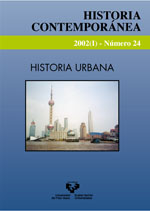La ciudad de México de finales del siglo XVIII: un diagnóstico desde la «ciencia de la policía»
##plugins.themes.bootstrap3.article.main##
##plugins.themes.bootstrap3.article.sidebar##
Abstract
The science of the police like government's practical doctrine acquired relevance during the XVIII century and it contributed to restate the territorial organization and the population's control. As well as it leaves of this politics, the reorganization of the urban space was a measure implanted in Madrid, capital of the Empire, after the mutiny of Esquilache and soon it extended to diverse cities of the peninsula and later on to the American cities and in particular to the city of Mexico. As for the capital of the New Spain, in the work some of the reaches of the measure and the state are analyzed by the one that crossed the city according to the diagnosis of two distinguished members of the political elite and practical followers of the police. It is pointed out that the optics of the police has been little explored by the specialists dedicated to the Mexican historiography and that the on measures in practice in Madrid and Paris became a practical model for the officials in charge of looking after the order and physionomy of the city of Mexico.
##plugins.themes.bootstrap3.article.details##
Authors publishing in the journal Historia Contemporánea agree to the following terms:
- Authors retain full copyright of their papers, but also grant copyright to the academic publisher (UPV/EHU Press) for the purposes of copyright management, vigilance and protection.
- Papers are by default published with a non-restrictive Creative Commons CC-BY-NC-ND 4.0. You are free to: Share, copy and redistribute the material in any medium or format. The licensor cannot revoke these freedoms as long as you follow the license terms. Under the following terms:
Attribution — You must give appropriate credit, provide a link to the license, and indicate if changes were made. You may do so in any reasonable manner, but not in any way that suggests the licensor endorses you or your use.
NonCommercial — You may not use the material for commercial purposes.
NoDerivatives — If you remix, transform, or build upon the material, you may not distribute the modified material.
No additional restrictions — You may not apply legal terms or technological measures that legally restrict others from doing anything the license permits.
- If an author requires a more restricted CC license (e.g. CC-BY-SA), this can be provided by contacting our publisher at: publications@ehu.eus
- In particular, and without having to request additional permission, CC BY-NC-ND licensed papers can be deposited in institutional repositories and academic web sites.
- Postprints (i.e. accepted but non-edited versions of the manuscript) can also be pre-published online, providing acknowledgement of authorship and source is specified as above.
For non-standard uses of papers or materials published in Historia Contemporánea, please contact our publisher UPV/EHU Press at: publications@ehu.eus

